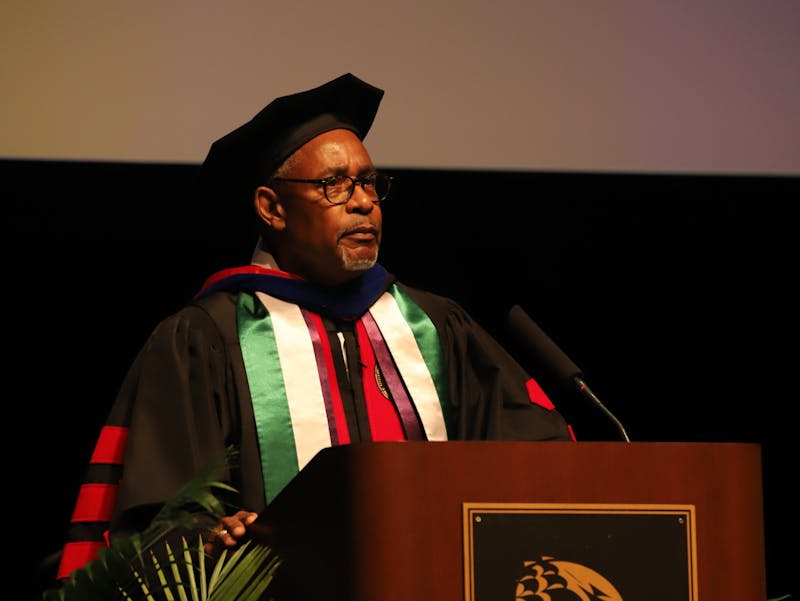For the first time in more than 50 years, students at Shippensburg University are breaking in new residence halls on campus.
Phase 1 of a lengthy three-phase housing replacement project opened in time for the beginning of the spring 2013 semester — with students moving into Presidents Hall, Seavers Hall and McLean Hall II at the end of finals week of the fall 2012 semester.
Dr. Roger Serr, SU’s vice president of Student Affairs said the university conducted tours during an open house at the end of the fall semester to give students and parents a glimpse of the new buildings. “There were a lot of students and their parents in the buildings and from what I understand that feedback was through-the-roof positive. Our current students who have seen it were also very excited as well.”
The paperwork for the next two phases is currently being written, and the entire project should be complete by summer 2015. The residency for next semester is very high — in the upper 90 percent range — with roughly 900 students set to get nestled into their new homes in January.
Some students have complained about the high cost of living in the new buildings, with the price ranging from $3,500 to $4,300 depending on the unit. With the high price of construction and the costs of the furnishings, the rent is more expensive to meet the obligations of the project.
But it is an expense that both Serr and Shippensburg University Student Services, Inc., (SUSSI) President Darrell Miller believe is worth taking on.
“Although the price is higher for the new residence halls than the current expense, if students are more comfortable and can select compatible roommates, it may lead to more learning and knowledge that can be invaluable to a better life and career,” Miller said.
Phase 1’s construction costs were just under $50 million, and with the development costs and financing added in, the total cost came to more than $70 million. The entire project will wind up costing $200 million by the time Phase 3 is finished. With a price tag that hefty, the school had to select a 501©(3) non-profit organization to fund the project.
Most schools simply select their foundations, but the Shippensburg University Foundation eventually backed out, making way for SUSSI to swoop in and accept the cost.
After that was straightened out, the school had to hire a developer and contractor. The Pennsylvania State System of Higher Education, of which SU is a member, had already identified 21 pre-approved developers through various construction projects, which helped Shippensburg narrow down the candidates. Several developers then responded to SU’s request for proposal.
The university narrowed its candidates down to three after further screening and negotiated with two of them before eventually settling on Campus Apartments based in Philadelphia as well as its architectural partner CUBE 3 Studio out of Massachusetts.
SUSSI then agreed to terms with a contractor, Harkins Builders, based in Maryland. The company agreed to a certain cost but got cold feet late in the negotiating stage when it saw the final totals exceeded what it had budgeted.
SUSSI wanted to close on the deal, but Harkins bailed, pushing the target date for the completion of Phase 1 from August 2012 to December 2012.
“That’s what made the whole thing slide, because once you miss it, poof, it’s gone,” said Bruce Herring, SU’s assistant director for planning and engineering. “You can’t move in mid-semester, you can move in winter break, but not in October or November.”
Campus Apartments had no previous working experience with Harkins, and with SUSSI left searching for a contractor, the company suggested a group that it had previously worked well with: Fortune Johnson, based out of Georgia.
This particular construction project was unique because of the many entities involved. Herring was one of the main designers while serving as the liaison between the design team and the school’s facilities management department and both Campus Apartments and Fortune Johnson.
“You have the university providing input and we rely heavily on our shops to make sure their input is involved, too,” Herring said. “And residence life and police and traffic and safety and all those people, but then the developer and contractor have a seat at the table as well.”
The construction project is easily the biggest and most expensive in the school’s history, despite the difficulty of recent projects such as the $26-million dollar CUB renovation (while the building was occupied) and the $10-million dollar construction of the H. Ric Luhrs Performing Arts Center. The university primarily handled those projects with little outside assistance.
“From a number of people involved, [this housing project is] definitely one of the more complex ones that I’ve ever had to deal with,” Herring said. “But it’s also been more rewarding because this is the only project we’ve had where there’s a different relationship with the contractor and they’re part of the team and part of the process from early on.”
The construction process did not come without its fair share of setbacks, however.
The fall and summer of 2011 were extremely wet, which immediately put the project behind schedule beginning in August. Shippensburg averages 35 inches of rain per year, but during the first 12 of the 16 construction months, the area received 75 inches of rain. The project accumulated weeks of contract delay days, including 22 in November alone.
The rain saturated the soil while also ruining dirt piles that had been intended to be put back in the ground. That dirt then needs to be compounded off-site (an additional expense) and fresh new soil needs to be purchased and shipped in its place.
Further, the geographic region where Shippensburg is located has karst soils, which is a mixture of solid granite, decaying granite and decaying soils that is hard to remove from the ground.
Small blasts helped clear some of the soils, but blasts were considered too dangerous to remove the soils that surrounded university utilities for fear of damage. Thus, construction crews had to use rock chippers to chip away at the karst soils.
“The students had to hear our rock chippers going 12, 13 hours a day for months and months, so it was aggravating and annoying to them, understandably, but also to us because it was slowing us down considerably,” said Tom Bradley, senior director of development for Campus Apartments. “Students complained to the university about the chipping but there was nothing anybody could do about it, it’s granite and we just had to keep trudging along until we were done.”
There was also a delay with getting the structural steel contract straightened out, which specifically pushed back construction of Building 1, according to Mark Knapley, senior project manager for Campus Apartments. The buildings are all wood-frame construction per the standards for residential units.
However, the basement level of Building 1 houses a wellness center, which is a commercial construction that requires stricter steel frames. The majority of the building’s construction thus could not move forward until the steel needed for the basement had arrived.
With all these issues holding the project back, construction took eight months to actually get off the ground when the plan had been for it to only take three or four months — all on a 16-month schedule.
Yet despite these holdups, Fortune Johnson made a commitment to finish the project on time even if it meant round-the-clock operations — a guarantee that Herring says the university does not typically see from contractors.
Week after week, the project began to slowly catch up on schedule and finally, in August 2012, the project was fully caught up to where it would have been sans the setbacks.
“Fortune Johnson went the extra mile and really staffed this project to try to get it done on time because we had problems with the steel design and weather and things like that that held them up. But they’ve bent over backwards to try to please us,” said Harry Carroll, SU’s assistant director for construction management.
“They made up all that lost time by overstaffing the project. They worked seven days a week and a lot of them are working 10-hour days. It’s pretty impressive the way they got all of them to buy into working that many hours, because you’re talking 35-40 people working on a Sunday and that’s a lot of overtime.”
The feeling is mutual, as Fortune Johnson considers Shippensburg University one of the most straightforward and cooperative clients it has worked with.
“There’s an old joke about how you have too many chiefs and not enough Indians, but all the chiefs here have all the same interests,” said Dennis Baldwin, group vice president for Fortune Johnson. “They all set the bar and they don’t move it, which is good for us. Everything has been consistent, and it’s nice when we can have that level of communication.”
Baldwin realizes that he may have burned his construction workers out with the amount of overtime and seven-day weeks they had to work over the last year to get the project caught up on schedule to meet the commitment they made to the university.
“I tell my guys that the shame of it in construction is that there’s no silver or bronze here for second and third,” Baldwin said. “You either get the gold or you don’t and everybody hates you for not living up to your commitment. We don’t break our commitments.”





The Slate welcomes thoughtful discussion on all of our stories, but please keep comments civil and on-topic. Read our full guidelines here.